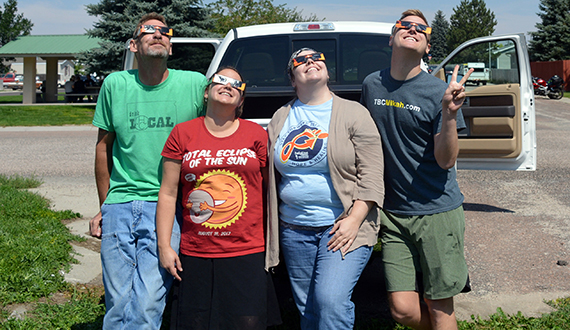
Former Rotary Scholar Mikah Meyer, right, views the solar eclipse with friends.
By Mikah Meyer, former Rotary Scholar
Have you ever seen a 360-degree sunset? If you’re like me and spend a lot of time outdoors, you know that doesn’t make sense. The sun rises in the east and sets in the west, creating a blinding view as you drive east in the morning and a radiant sunset full of colors in the west in the evening. But a 360-degree sunset? Sounds like science fiction. But it’s not.
Fiction, anyway. It is science, which allowed scientists to predict that on Monday, 21 August, we would be able to view a total solar eclipse on a “path of totality” from the jagged coast of Oregon to the brackish marshes of South Carolina. Having been in both those places this year as part of my world record attempt road trip to all 417 National Park Service sites, everyone naturally asked at which national park I’d be viewing this rare event.
I had planned on being at Agate Fossil Beds National Monument in northwest Nebraska. But days before the eclipse, the forecast predicted clouds. Having just seen the surreal sunsets of Badlands National Park in South Dakota, I decided my backup would be these otherworldly rock formations that become magical when the sun is soft. I’d never experienced an eclipse before, so Badlands’ 96 percent totality sounded good enough.

The solar eclipse in Wyoming.
But thank the sun and moon there was a storm forecast in Badlands the day of the eclipse. That sent me to Lusk, Wyoming: a random town in the middle of nowhere that was within the path of totality and had a prediction of completely clear skies. Without that turn of events, I wouldn’t have experienced the total solar eclipse, with its corona-brimmed moon and magical 360-degree sunset. It was a sight I may never again see in my lifetime.
So if the chance arises for you to view a future eclipse, say in 2024, do whatever you can to get to the path of totality. It will be one sunset you never forget.
Learn more about former Rotary Scholar Mikah Meyer and his National Parks journey at www.MikahMeyer.com

Reblogged this on shanakyar.
LikeLike
wonderful – these alumni leave me breathless with their achievements!
LikeLike
Pingback: Rotary Scholar in the path of the eclipse | The Rotary Club of Carteret